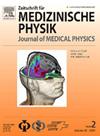通过使用开源 TPS 脚本的 VMAT 计划复杂性指标,减少针对患者的质量保证。
IF 4.2
4区 医学
Q2 RADIOLOGY, NUCLEAR MEDICINE & MEDICAL IMAGING
引用次数: 0
摘要
目的:容积调制弧形疗法(VMAT)是一种广泛应用于普通分次放射治疗(NFRT)和立体定向体放射治疗(SBRT)的技术。该技术需要进行剂量率调制、准直器移动和龙门旋转同步,硬件负担很重。患者特定质量保证(PSQA)可确保直列加速器能够精确地提供计划剂量。然而,PSQA需要花费大量时间,因此应研究既能减少时间又能保证计划可实施性的一类解决方案:本研究使用内部开发的 Eclipse Scripting API (ESAPI) 脚本从 N = 667 个 VMAT 治疗区域中提取五个独立的计划复杂性指标。利用皮尔逊相关性、箱形图分析和接收器操作特征曲线研究了指标与门户剂量测定测量之间的相关性,并以此确定了性能最佳的指标及其阈值:未达到临床 PSQA 标准 3%/2mm(NFRT)和 3%/1.5mm(SBRT)的视野发生率较低(N = 1)。平均 MLC 开口是与门静脉剂量测定数据相关性最高的指标,也是区分 PSQA 要求的最佳指标之一。16.12毫米(NFRT)和7.96毫米(SBRT)的阈值对应的真实阳性率高于90%:这项工作提出了一种定量方法,通过识别需要专门测量的最复杂计划来减少 PSQA 的时间分配。所提出的方法需要对大约 10% 的计划进行 PSQA。ESAPI 脚本是开源的,便于其他机构进行研究和实施。本文章由计算机程序翻译,如有差异,请以英文原文为准。
Reduction of patient specific quality assurance through plan complexity metrics for VMAT plans with an open-source TPS script
Purpose
Volumetric modulated arc therapy (VMAT) is a widespread technique for the delivery of normo-fractionated radiation therapy (NFRT) and stereotactic body radiation therapy (SBRT). It is associated with a significant hardware burden requiring dose rate modulation, collimator movement and gantry rotation synchronisation. Patient specific quality assurance (PSQA) guarantees that the linacs can precisely and accurately deliver the planned dose. However, PSQA requires a significant time allocation and class solutions to reduce this while guaranteeing the deliverability of the plans should be investigated.
Methods
In this study, an in-house developed Eclipse Scripting API (ESAPI) script was used to extract five independent plan complexity metrics from N = 667 VMAT treatment fields. The correlation between metrics and portal dosimetry measurements was investigated with Pearson correlation, box plot analysis and receiver operating characteristic curves, which were used to defined the best performing metric and its threshold.
Results
The incidence of fields failing the clinical PSQA criteria of 3%/2mm (NFRT) and 3%/1.5mm (SBRT) was low (N = 1). The mean MLC opening was the metric with the highest correlation with the portal dosimetry data and among the best in discriminating the requirement of PSQA. The thresholds of 16.12 mm (NFRT) and 7.96 mm (SBRT) corresponded to true positive rates higher than 90%.
Conclusions
This work presents a quantitative approach to reduce the time allocation for PSQA by identifying the most complex plans demanding a dedicated measurement. The proposed method requires PSQA for approximately 10% of the plans. The ESAPI script is distributed open-source to ease the investigation and implementation at other institutions.
求助全文
通过发布文献求助,成功后即可免费获取论文全文。
去求助
来源期刊
CiteScore
3.70
自引率
10.00%
发文量
69
审稿时长
65 days
期刊介绍:
Zeitschrift fur Medizinische Physik (Journal of Medical Physics) is an official organ of the German and Austrian Society of Medical Physic and the Swiss Society of Radiobiology and Medical Physics.The Journal is a platform for basic research and practical applications of physical procedures in medical diagnostics and therapy. The articles are reviewed following international standards of peer reviewing.
Focuses of the articles are:
-Biophysical methods in radiation therapy and nuclear medicine
-Dosimetry and radiation protection
-Radiological diagnostics and quality assurance
-Modern imaging techniques, such as computed tomography, magnetic resonance imaging, positron emission tomography
-Ultrasonography diagnostics, application of laser and UV rays
-Electronic processing of biosignals
-Artificial intelligence and machine learning in medical physics
In the Journal, the latest scientific insights find their expression in the form of original articles, reviews, technical communications, and information for the clinical practice.

 求助内容:
求助内容: 应助结果提醒方式:
应助结果提醒方式:


